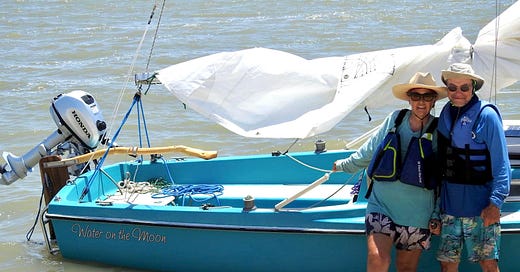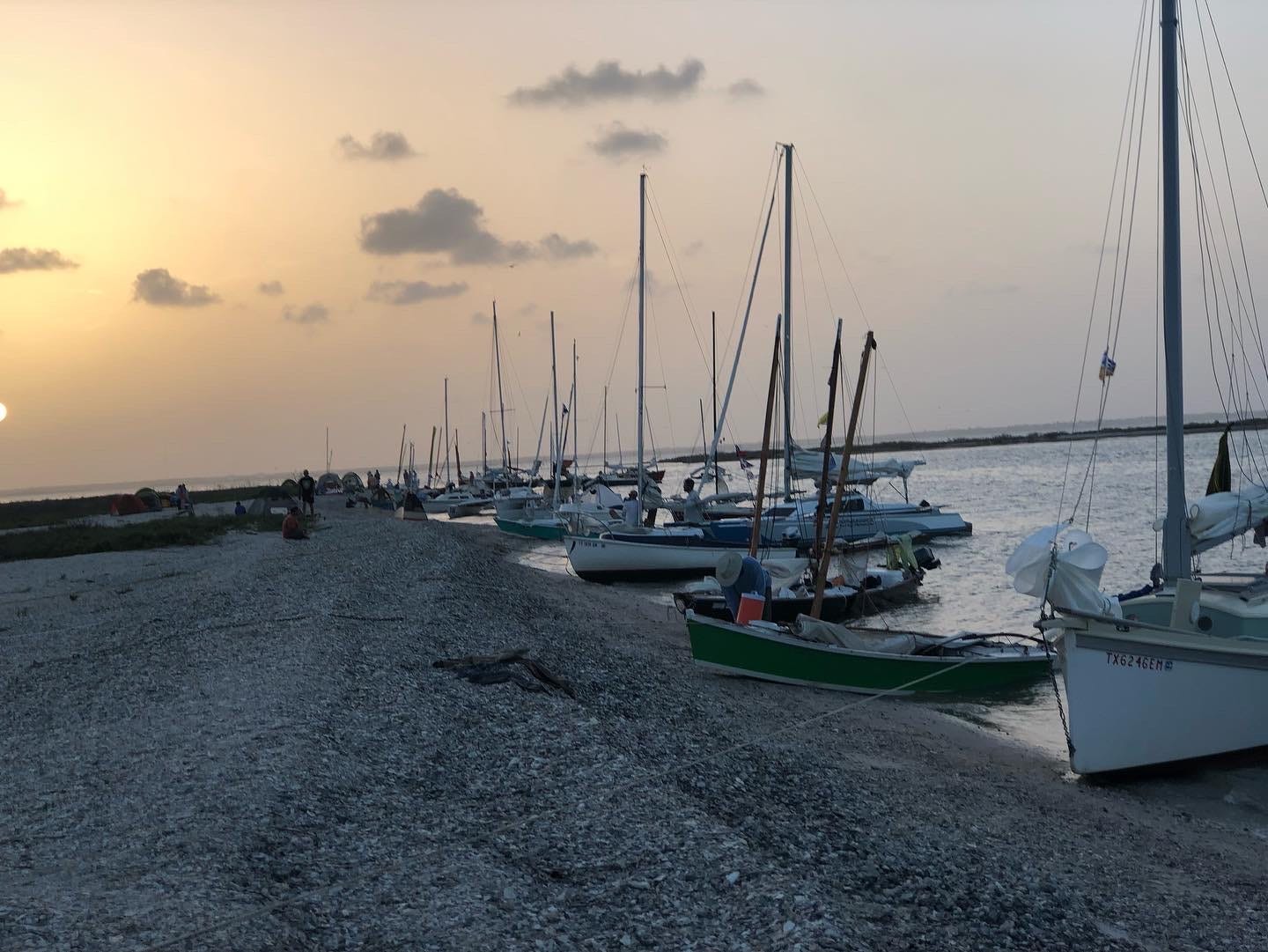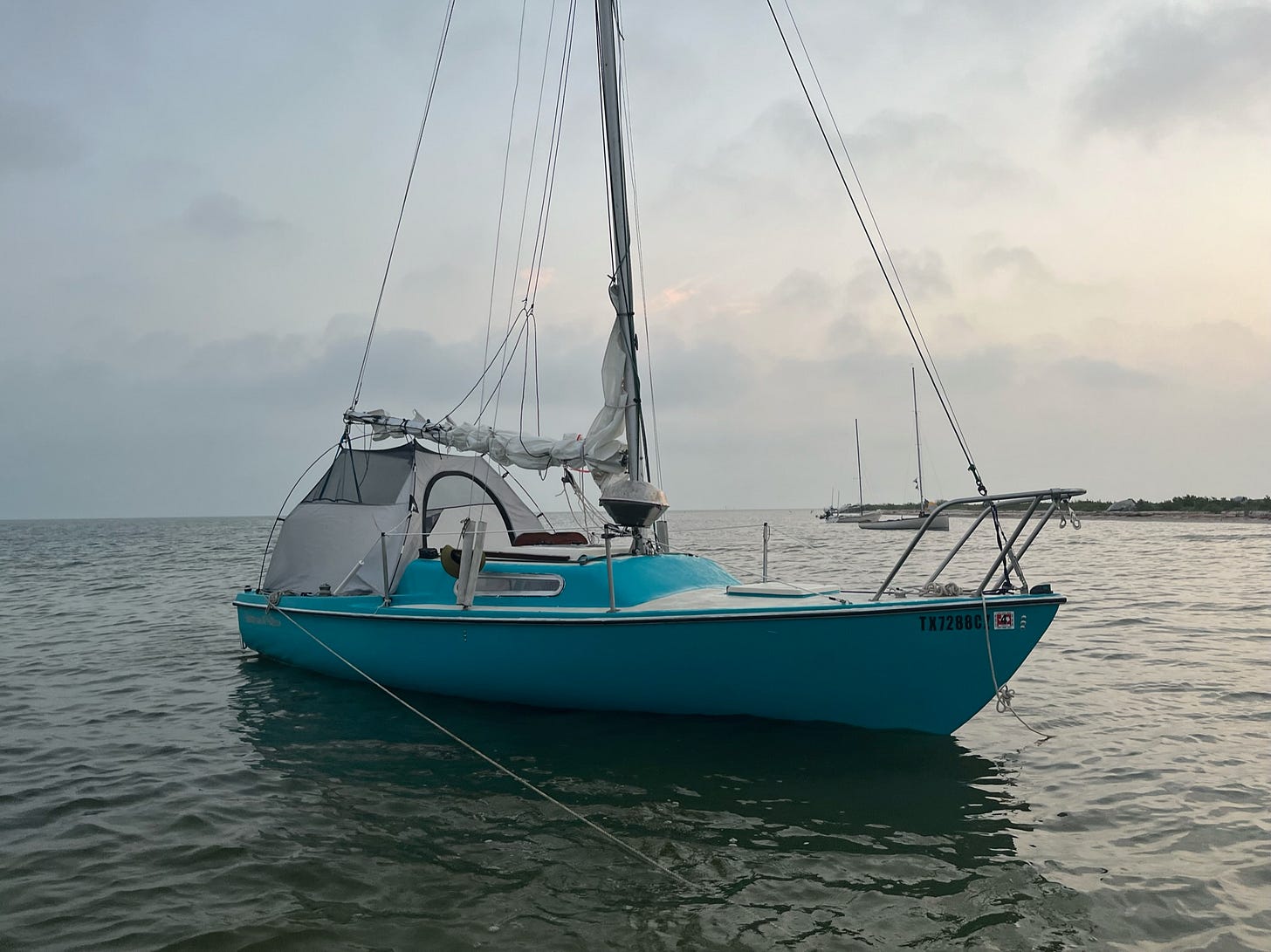My First Texas 200
"So despite my fear and anxiety I decided if he was going to die on this mad endeavor I would die beside him."
Article by Jennifer Harnett
The Texas 200, a 200-mile run up the Texas coast was an event that I thought was insane from the time I first heard of it a couple years after we moved to South Texas. The US-Mexico border—camping every night on deserted barrier islands—to Magnolia Beach, a small beach close to our home. The event is billed as a week-long raid styled endurance run up the Texas coast and often includes comments like “you may die, break your boat, or break your body and soul.”
We moved to South Texas in 2015 and had spent our sailing time on a lake in the Ozarks. Upon moving here we tried sailing at the beach and after getting stuck repeatedly, feeling like we had no control of the boat and in a state of panic, decided we couldn’t sail in saltwater and put our 1974 MacGregor Venture up for sale. Luckily no one wanted our boat and it never sold.
In 2017 we happened to be at the beach as the Texas 200 was ending and all the sailboats were coming in. As we watched sailboats as small as 12 feet made from plywood land on the beach after completing 200 miles, my husband, John, was convinced there was no reason why we couldn’t sail on the bay. When we saw that at least three McGregors also completed the event he was completely hooked. From that moment John, and my son, drooled over the webpage and Facebook page planning future adventures.
For the next several years we slowly got used to sailing the boat in the Gulf and he made plans to completely restore the boat. While I did enjoy going out on daysails again, I still considered the Texas 200 an event only for the deranged.
I liked sailing only when the wind speed was between 10 to 15 knots and would religiously check forecasts before every outing. I’m not sure I would have described myself as a sailor—more like a timid passenger who would scream in fear anytime we got a gust over 15 knots. I hate the boat tilting over 15 degrees and would shriek my dislike if we ever were put in that position.
Despite my pleading and discouragement John completely restored the sailboat and signed up to participate in the 2022 Texas 200. The plan was that he and our son would take part in the event. However, my son had recently taken a job on a barge and as time came close for the event it became evident he wouldn’t be able to get the time off from his new job. John was still determined he could do it solo and all I could think of was that he was going to die. So despite my fear and anxiety I decided if he was going to die on this mad endeavor I would die beside him.
So despite my fear and anxiety I decided if he was going to die on this mad endeavor I would die beside him.
We didn’t have a lot of time to prepare since boat restoration took longer than expected. However, we read most of the stories on the Texas 200 webpage and planned our survival gear based on other peoples' stories of peril. We had a fish finder, handheld Garmin, paper maps and cell phones for navigation, and three reefs in the sail (two of which I had sewn despite no previous sail sewing experience). We had tools and supplies for every emergency—solar panels, a 12-volt battery, and a back-up camping solar panel for our electrical needs. We carried camping gear, food, communication, first aid supplies, insect spray, and plenty of libations (for my courage). Strapped to my lifejacket was the radio, knife, air horn, whistle and signaling mirror. We were as prepared as we would get.
The day of the event came and the forecast for the day was 20 knots of wind increasing to 25 with gusts of 30 knots later in the day before ending the day with winds between 15 to 20 knots. In addition to the high winds being forecast there were also heat index warnings forecast with a heat index of 105 ore more everyday for the rest of the week. Despite my apprehension, it was time to start our adventure.
We exited Port Mansfield and hoisted our sails in the Laguna Madre, two reefs in the sail, and were immediately hit with strong winds. The first day was supposed to be an easy 8-mile sail. We made two miles and got stuck. Despite the depth finder saying we were in four feet of water, our keel struck shallow land and we quit moving. Luckily we were able to raise the keel and easily get off the sand bar. We almost immediately got stuck for a second time, again with the depth finder saying we had water. At this point we had already encountered two problems in less than an hour and I wanted to go back to Port Mansfield and stop this crazy escapade. However, with so many problems we decided to modify our route and skip out on the first camp and head towards the protected land cut along the ICW.
Since both of our nerves were already frazzled we decided to anchor and have lunch before we continued. Little did we know what a disaster that would become. As we ate lunch the wind picked up from 20 knots to 25 knots with even stronger long gusts of wind, the seas also swelled with waves of three feet and up. When we went to pull up the anchor it wouldn’t come up and we swirled around bucking waves in the high wind. Unfortunately we were also on the windward side of a sandbar island.
Neither John nor I could pull the anchor up no matter how hard we tried. The anchor rode was also turning black and hot from rubbing, and the threat of it breaking was foremost in our thoughts. When I said earlier that I was a passenger on the boat, that best described my skill and ability. So when John told me I needed to run the motor so he could pull up the anchor my answer was a resolute no. It was the only option though to save the boat and ourselves. After offering me a short lesson on how to run the motor, John went to pull up the anchor. By some sort of miracle, as I ran the motor forward the anchor came free. However, almost immediately we had a new impending doom as we drifted towards that windward island. Luckily John got to the back of the boat and was able to give the engine enough power to pull us out of the current that was forcing us towards the sandbar.
Immediately our boat sucked into the swell of choppy water, and we went from seeing our bow swallowed by one wave only to see our aft end sucked in by the next wave. By this time I had retreated to the floor of the cabin in tears, begging to call the Coast Guard for an emergency rescue and to desert the boat. The boat was in a relatively safe area by this point and was left trolling and bucking waves as John tried to convince me I could go on. I spent several hours listening to weather radio as John begged to move the boat a little bit faster. Eventually the wind slowed some and the waves leveled out and we picked up a little speed and headed towards protected land.
We made it to the entrance of the ICW, which is in a narrow strip of land called The Land Cut. We pulled onto shore to prepare for our first night's camp. We were told to expect mud along Land Cut but nothing prepared me for sinking into mud up to my shins upon exiting the boat. The mud seemed to get worse with every step and stunk like the devil vomited crude oil and fish guts onto the land. By the time we got all the camping gear to the shore we were covered in mud and exhausted.
Since we had revised our passage the previous day our second day of sailing was a short 10 miles trip further up ICW into the Land Cut. Yet again though our camp was in the Gulf mud and for the second day we wallowed in the mud as we moved all our gear to the second camp. Even though we made it to camp by noon we took the day to regroup, meet some new friends, and gather our energy to continue on.
Since we were anchored along the ICW, with big barges passing by all night, we left the navigation lights on. Unfortunately, our battery drained very low that night. The day was also shady and the solar panel didn’t keep up with our energy needs and killed our battery. The death of our 12 volt battery also meant the end of our primary navigation and the use of our depth finder. We were forced to go to our back ups of a camping solar panel to charge phones, a handheld Garmin, and paper maps. The Garmin was not detailed enough to provide many details about our location or route and left us with the paper maps for our primary navigation.
As we sailed on the third day we heard one of the boats hailing the Coast Guard with an emergency after getting stuck on a sandbar. As we listened to chatter back and forth between the Coast Guard and the boat, we noted the boat couldn’t figure out how to give the Coast Guard their location, other than the ICW marker number. I suddenly realized without our fishfinder I would have no way of giving the Coast Guard our GPS coordinates if we had problems again. I made a decision to circle every ICW marker as we went past it so that I could call for help with the marker number and map section if needed.
Day three involved sailing through Baffin Bay, a section of water known for being windy and rough. Unfortunately, day three, just like day one and two, called for a small craft advisory in the afternoon with sustained winds of 25 knots, even higher gusts and waves of 3 feet. By this point I was begging John to let us just drop out, but in the Land Cut there is no place to drop out since there are no boat ramps. We took off with two reefs in the sail and my stomach churning with fear. Even though Baffin Bay was just as rough as expected and we were surfing one wave into the next, we made it through and I felt my sea legs growing under me the slightest bit.
The third day ended at the Sand Dunes, which was the best campground of the whole trip. We spent the evening surrounded by other sailors on a deserted barrier island made of huge sand dunes. Even though the sail there had its share of difficulties as we sailed through shallow water using nothing but our keel as our depth finder, and in strong winds, swimming and camping at the sand dunes made it all worth it.
The fourth day included our one stop at a marina. We were able to experience air conditioning and running water for the first time in four days. All of this made for a difficult decision for me—continue on or not? 90 percent of me wanted to quit, I figured I could surely find a ride home, but John was determined that he would continue. In the end I stood by my original decision to continue on this mad adventure following it wherever it led. However, for the first time I also felt a small bit of hope that we could actually do this.
We had to go through Port Aransas, which meant navigating through ferry traffic and some of the heaviest barge traffic. Despite my fear and anxiety of navigating through traffic it was luckily anticlimactic and we easily passed through this area. The fourth day was also the first day that began with a weather forecast that didn’t include a small craft advisory for the afternoon and winds were forecast to top off at 20 knots. This was also our longest sail of the trip, and involved crossing Corpus Christi and Aransas Bay, two more bays known to be rough. The lightening winds and my increased confidence made the sail on this day seem routine. We sailed the entire without me screaming out in fear or feeling extremely anxious.
Day five started like every other day, up at 5am ready to sail. We had two choices on how to sail it—one involved going down through small cutouts in shallow water down the back of the Espiritu Santo Bay to reach camp 5, Army Hole. The other choice was to take the ICW most of the way and take a cut off to the Espiritu Santo Bay with an 8 mile sail to the northeast in deeper water to reach Army Hole. Since we did not have a depth finder we chose to take the ICW most of the way.
By the time we got to the Dewberry cutoff to get off the ICW and start sailing towards Army Hole it was already 7pm and we had 2 hours of sunlight left. Upon turning into the Espiritu Santo bay we were hit with wind and waves equal in strength to those on our first day’s mishap. Fear immediately gripped me as we faced similar conditions. John also felt anxious about the sailing conditions and the time of day, so he turned us back around towards the ICW.
By this point over an hour had passed and it was starting to get dark so our options were limited. We made a decision to pull as far on land as we could and anchor up for the night at Dewberry cut off along the ICW.
Anchoring along the ICW came with its own problems, the first being this is a busy barge area and we had no navigation lights. What we did have were two sets of Harbor Freight solar rope lights. We ran one set of rope lights partially up the mast and the second set on our stern. All night we expected a knock from the Coast Guard for our lack of proper navigation —but luckily that never came.
The other problem was that for us to anchor at this location meant that we were stuck on shallow land at the side of the ICW and we didn’t know if we would be able to get off the anchorage in the morning. John got up at three in the morning and started studying our predicament to figure out how we could get free in the morning. He finally figured out that as barges came by they put out enough wake that if we pushed right after one came by we might get free from our anchorage. So we got out and waited for a barge to pass and its wake to raise the water and pushed as hard as we could and amazingly freed the boat.
Day six was a short sail to the end with light wind that had us motoring more than sailing. Pulling up to Magnolia Beach had never looked so good or seemed so rewarding. We had completed our first Texas 200.
It took me three years to finally get up the courage to write about our first Texas 200 experience. I hope the sailing community will not judge our mistakes too harshly, because we had many. I learned a great deal about myself that first year—mainly that I am capable of a lot more than I thought I was. Since this first year we have completed two additional Texas 200s and will be taking place in our fourth this June. •SCA•
https://texas200.com/home







Excellent story, thank you!
Being willing to make mistakes and learn from them is an important part of sailing and of life. Experience leads to confidence. That said, I don't really love heeling a lot unless it is accompanied by sailing fast. I hope you have grown to truly enjoy sailing.